Abstract
We evaluated two types of wire-mesh minnow traps for sampling mummichogs (Fundulus heteroclitus) from intertidal rivulets on the surface of a salt marsh. In field trials, mean catch (no. of fish trap−1) did not differ significantly between trap types nor across soak times ranging from 30 to 240 min. Catch rate (no. of fish trap−1 min−1) was significantly (K-W ANOVA on ranked data, H4df=24.79; p<0.001) greater at shorter soak times, and larger size classes (>45 mm TL) of fish were relatively more abundant (Kolmogorov-Smirnov test, p<0.0001) in collections from double-funnel cylindrical traps (volume=10,330 cm3) compared to rectangular traps having about twice the volume and a single funnel cylindrical traps (volume=10,330 cm3) compared to rectangular traps having about twice the volume and a single funnel opening. We estimated entry and escape rates by adding marked fish to traps at initial densities of 30, 60, and 120 trap−1 and measuring changes in the numbers of marked and unmarked fish in each trap type at soak times ranging from 15 to 120 min during the flood stage of the tidal cycle. Escape rate was almost, twice as great from the two-funnel cylindrical traps (0.77 fish min−1) than from the single-funnel rectangular type (0.42 fish min−1) but entry rates did not differ significantly (K-W ANOVA, H4df=0.06; p=0.813) between trap types. Escape rate increased and entry rate decreased as fish density within traps was increased. Escape rates were highest immediately following immersion of the traps, but approached a constant value after 30 min. Trap-specific rates of entry and escape can be affected by a variety of factors including physical characteristics of different trap types, method and timing of trap deployment, and fish behavior. Catch data from minnow traps are unlikely to be useful in measuring relative abundance of mummichogs among habitats unless very short soak times (≤60 min) are used and calibration tests are performed. Use of longer soak times virtually ignores the dynamics involved in determining catch, and is unlikely to provide accurate information on either abundance or size distribution of mummichogs from tidal marsh habitats.
Similar content being viewed by others
Literature Cited
Ambrose, R. F. andD. J. Meffert. 1999. Fish-assemblage dynamics in Malibu Lagoon, a small, hydrologically altered estuary in southern California.Wetlands 19:327–340.
Breder, Jr.,C. M. 1960. Design for a fry trap.Zoologica 45:155–164.
Butner, A. andB. Brattstrom. 1960. Local movements inMenidia andFundulus.Copeia 1960:139–141.
Chisnall, E. L. 1996. Habitat associations of juvenile shortfinned eels (Anguilla australis) in shallow Lake Waahi, New Zealand.New Zealand Journal of Marine and Freshwater Research 30:233–237.
Chivers, D. P. andJ. F. Smith 1994. Intra- and interspecific avoidance of areas marked with skin extract from brook sticklebacks (Culaea inconstans) in a natural habitat.Journal of Chemical Ecology 20:1517–1524.
Dittman, A. H., G. S. Brown, andC. J. Foote. 1998. The role of chemoreception in salmon-egg predation by coastrange (Cottus aleuticus) and slimy (C. cognatus) sculpins in Lliamna Lake, Alaska.Canadian Journal of Zoology 76:406–413.
Flageole, S. andR. Leclair, Jr. 1992. Etude démographique d’une population de salamandres (Ambystoma maculatum) à l’aide la méthode squeletto-chronologique.Canadian Journal of Zoology 70:740–749.
Fulling, G. L., M. S. Peterson, andG. J. Crego. 1999. Comparison of Breder traps and seines used to sample marsh nekton.Estuaries 22:224–230.
Halpin, P. M. 1997. Habitat use patterns of the mummichog,Fundulus heteroclitus, in New England. I. Intramarsh variation.Estuaries 20:618–625.
He, X. andD. M. Lodge. 1990. Using minnow traps to estimate fish population size: The importance of spatial distribution and relative species abundance.Hydrobiologia 190:9–14.
Jackson, D. A. andH. H. Harvey. 1997. Qualitative and quantitative sampling of lake fish communities.Canadian Journal of Fisheries and Aquatic Sciences 54:2807–2813.
Kneib, R. T. 1976. Feeding, reproduction, growth and movements of killifishes on a North Carolina salt marsh. Master’s Thesis, University of North Carolina. Chapel Hill, North Carolina.
Kneib, R. T. 1982. The effects of predation by wading birds (Ardeidae) and blue crabs (Callinectes sapidus) on the population size structure of the common mummichog,Fundulus heteroclitus.Estuarine, Coastal and Shelf Science 14:159–165.
Kneib, R. T. 1986. Size-specific patterns in the reproductive cycle of the killifish,Fundulus heteroclitus, (Pisces: Fundulidae) from Sapelo Island, Georgia.Copeia 1986:342–351.
Kneib, R. T. 1997. The role of tidal marshes in the ecology of estuarine nekton.Oceanography and Marine Biology: An Annual Review 35:163–220.
Kneib, R. T. 2000. Salt marsh ecoscapes and production transfers by estuarine nekton in the southeastern United States, p. 267–291.In M. P. Weinstein and D. A. Kreeger (eds.), Concepts and Controversies in Tidal Marsh Ecology. Kluwer Academic Publishers, The Netherlands.
Kneib, R. T. andS. L. Wagner. 1994 Nekton use of vegetated marsh habitats at different stages of tidal in undation.Marine Ecology Progress Series 106:227–238.
Langston, M. A. andD. M. Kent. 1997. Fish recruitment to a constructed wetland.Journal of Freshwater Ecology 12:123–129.
Meredith, W. H. andV. A. Lotrich. 1979. Population dynamics of a tidal creek population ofFundulus heteroclitus (Linnaeus).Estuarine and Coastal Marine Science 8:99–118.
Munro, J. L. 1974. The mode of operation of Antillean fish traps and the relationships between ingress, escapement, catch and soak.Journal du Conseil International pour l’Exploration de la Mer 35:337–350.
Munro, J. L., P. H. Reeson, andV. C. Gaut. 1971. Dynamic factors affecting the performance of the Antillean fish trap.Proceedings of the Gulf and Caribbean Fisheries Institute 23:184–194.
Recksiek, C. W., R. S. Appeldoorn, andR. G. Turingan. 1991. Studies of fish traps as stock assessment devices on a shallow reef in south-western Puerto Rico.Fisheries Research 10:177–197.
Reebs, S. G., L. Boudreau, P. Hardie, andR. A. Cunjak. 1995. Diel activity patterns of lake chubs and other fishes in a temperate stream.Canadian Journal of Zoology 73:1221–1227.
Robichaud, D., W. Hunte, andM. R. Chapman. 2000. Factors affecting the catchability of reef fishes in Antillean fish traps.Bulletin of Marine Science 67:831–844.
Robichaud, D., W. Hunte, andH. A. Oxenford. 1999. Effects of increased mesh size on catch and fishing power of coral reef fish traps.Fisheries Research 39:275–294.
Rozas, L. P. andM. W. LaSalle. 1990. A comparison of the diets of Gulf killifishFundulus grandis Baird and Girard, entering and leaving a Mississippi brackish marsh.Estuaries 13:332–336.
Rozas, L. P. andT. J. Minello. 1997. Estimating densities of small fishes and decapod crustaceans in shallow estuarine habitats: A review of sampling design with focus on gear selection.Estuaries 20:199–213.
Sheaves, M. J. 1992. Patterns of distribution and abundance of fishes in contrasting habitats in a mangrove-lined tropical estuary as determined by fish, traps.Australian Journal of Marine and Freshwater Research 43:1461–1469.
Sheaves, M. J. 1995. Effect of design modifications and soak time variations on Antillean-Z fish trap performance in a tropical estuary.Bulletin of Marine Science 56:475–489.
Sokal, R. R. andF. J. Rolhf. 1995. Biometry, 3rd edition. W. H. Freeman and Company, New York.
Valiela, I., J. E. Wright, J. M. Teal, andS. B. Volkmann. 1977. Growth, production and energy transformations in the saltmarsh killifishFundulus heteroclitus.Marine Biology 40:135–144.
Whitelaw, A. W., K. J. Sainsbury, G. J. Dews, andR. A. Campbell. 1991. Catching characteristics of four fish-trap types on the north west shelf of Australia.Australian Journal of Marine and Freshwater Research 42:369–382.
Author information
Authors and Affiliations
Corresponding author
Rights and permissions
About this article
Cite this article
Kneib, R.T., Craig, A.H. Efficacy of minnow traps for sampling mummichogs in tidal marshes. Estuaries 24, 884–893 (2001). https://doi.org/10.2307/1353179
Received:
Accepted:
Issue Date:
DOI: https://doi.org/10.2307/1353179




